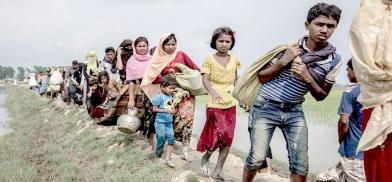Rohingya crisis in Bangladesh: No light at the end of the return tunnel
There is no light at the end of the repatriation tunnel; one must look at other more viable and pragmatic scenarios rather than transporting almost a million people at gunpoint to Rakhine

The 2017 Rohingya influx into Bangladesh has been seen as one of the world's most disastrous humanitarian crises, but influxes into Bangladesh have been there since the seventies when the country was formed. The refugees had three significant mass migrations, or even we can say they were forcibly pushed out in an exodus.
The first mass influx of Rohingya refugees into Bangladesh was in 1978, then in the early nineties and then the major exodus in 2017. Almost 720,000 came to Bangladesh in 2017. This is not to mention the almost steady stream of refugees or migrants from 1978 to the border areas of Bangladesh since the first mass exodus.
Most Rohingya refugees are Muslims. During a 2019 visit to the major Rohingya refugee camp called Kutapalong, we discovered a Rohingya Buddhist who converted to Islam and married a Bangladeshi Muslim girl who is now living in Bangladesh. She explained that many migrate from Rakhine State in Myanmar to Bangladesh and convert to Islam for a better and more peaceful life. A section of them has been staying in Bangladesh since 1978. Even most of the second generation of the first two early arrivals of the Rohingyas have become citizens of Bangladesh.
The Rohingya refugees crossed the border from Rakhine and came to Cox’s Bazar and the area has become overpopulated because of this influx. Authorities in Bangladesh have thought about relocating the refugees to the island of Bhasan Char. As of February 2022, there are 19,000 Rohingya refugees on the island. Houses have been built for the Rohingyas there to live a modern and better life, in addition to dormitories, schools, mosques, hospitals, playgrounds, wide roads, lighthouses, solar systems, food storage warehouses, mobile phone towers, sewerage systems, and super sewers. The government of Bangladesh has invested approximately BDT 3,900 crore in the Bhasan Char project. As a result, the displaced refugees will be able to live comfortably. In many cases, it has been reported that refugees are earning close to BDT 30,000 on the island.
Rohingya future uncertain
Bangladesh is still a very underdeveloped and crowded nation. Even before the 2017 mass displacement, the Cox's Bazar camps of Kutupalong and Nayapara housed more than 34,000 officially registered Rohingya people. Most if not all humanitarian organizations like the UNHCR possibly want the refugees to live a secure life. For a country like Bangladesh, which is not a signatory of the 1951 UN Refugee Convention but closely follows much of it, it's difficult for the economy of a developing country to carry on with refugees.
The future of the Bangladesh economy is worrisome, which even Prime Minister Sheikh Hasina has alluded to. This will affect the refugees who are in one of the poorest parts of the country; compared to Dhaka which has a 35 per cent poverty rate; the region of Cox’s Bazar has a very high poverty rate of 85 per cent (World Bank). Also, the area is prone to natural disasters, such as floods and cyclones, and has a lack of access to basic services, such as healthcare and education.
At present, the country is suffering from food, power, and fuel shortages. The prices of necessary commodities prices have gone up to affect even the upper middle classes. Also, during the COVID-19 pandemic, there was high unemployment, as well as many businesses shut down. The unemployment rate in Bangladesh increased from 4.3 per cent in 2019 to 5.4 per cent in 2020. Many people who lost their jobs are still unable to find new ones and businesses cannot reopen because there is no capital to start with.
It is also difficult to get loans from banks to start or resume business; one major reason for that is the high rate of corruption in Bangladesh and another is the underdeveloped banking system. Another major fallout of the pandemic was the lower remittances from expats whom Bangladesh's economy heavily relies on.
Worse times to come
PM Hasina has asked the farmers to produce more food to fight against a possible famine. But with the lack of power, fuel, and fertilizers, it becomes difficult, if not impossible to produce more. In this situation of economic downturn and scarcity, what will happen to the refugees?
Myanmar is still dealing with civil unrest after the military coup in February 2021. It would be unwise to think that the MYanmar military junta will have refugee repatriation as its priority. The Buddhist country has seen a shift in the treatment of Muslims. The UNHCR has already declared the Rohingya crisis a protracted refugee situation. Bangladesh has sought international help as well as regional help from China and India, but there has been little done towards the repatriation of the refugees.
There is no light at the end of the repatriation tunnel; one must look at other more viable and pragmatic scenarios rather than transporting almost a million people at gunpoint to Rakhine. The question now is what will happen to the refugee camps as Bangladesh goes through an economic downturn? What will be the standard of life of the refugees - so far used to good treatment - in the coming years?
(Swadesh Roy is a Dhaka-based editor. Safen Roy studies at the Graduate School of Chulalongkorn University, Bangkok, Thailand. They can be contacted at swadeshroy@gmail.com. Views are personal.)








Post a Comment